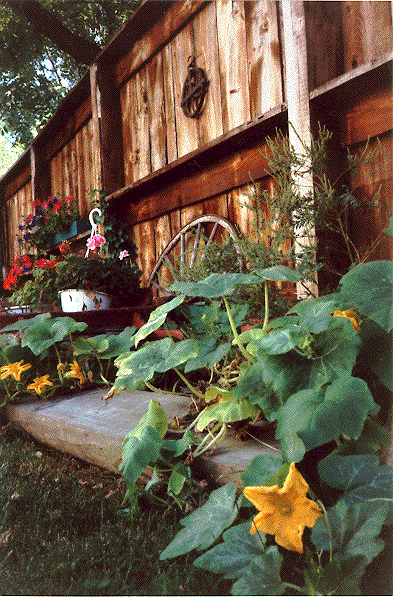

The yellow vine with yellow flowers is a pumpkin. I only got two pumpkins last year because I planted them in July, but I'm ready with my peat-pots this year. The wheel against the fence is from an old farm carriage. The fence itself is pine stained (if you believe it) with creosote, the sealer used to treat railway ties. Of all of the stains I tried, creosote actually produced the richest colour, and showed off the grain the best. The beams of the fence are 5" x 7", sunk four and a half feet in concrete. The mennonite at the sawmill asked me if I was building a fence for bulls. You can see one of the logs used to cut planks for the fence underneath the pumpkin vine. This view shows how the fence forms a distinct border that runs along the eastern perimeter of the garden.
THE PROBLEM HAS BEEN SOLVED! The tree in the background (a black walnut) used to be a pain. I could never find anything to grow under it because of a toxin called Juglone that it emits. Well, Angela Henderson wrote me and brought my search for black walnut-hardy plants to an end. Here, thanks to her, is a list of plants which are immune to the Juglone toxin in the root system of Black Walnut trees:
anemone, jack-in-the-pulpit, lady fern, cyclamen, epimedium, dog's-tooth-violet, gentian, green hellebore, alumroot, hosta, iris, lilies, ostrich fern , forget-me-not, narcissus, lily turf, blue grasses, may-apple, Solomon's seal, Christmas fern, primroses, pilewort, nightshade, meadow-rue, toad lily, white clover, trillium, periwinkle, hickories, burning bush, forsythia, red cedar, honeysuckles, virginia creeper, mockorange, oaks, poison ivy, black raspberry, lilacs, viburnums, grape
THANKS ANGELA!